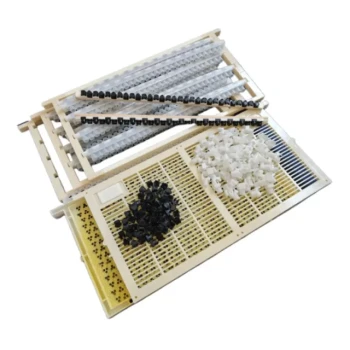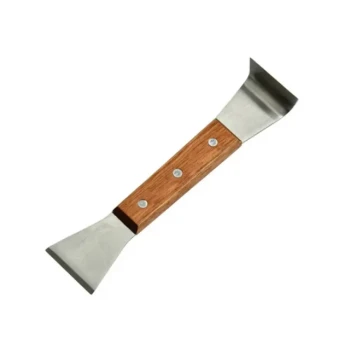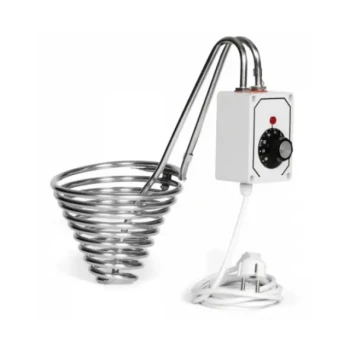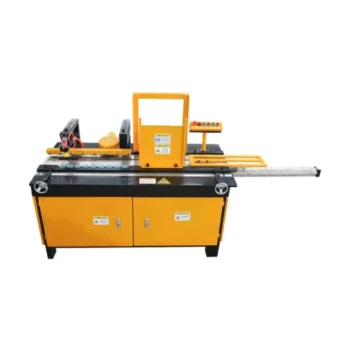To raise queen bees without grafting, the most common methods involve creating a queenless colony and allowing the bees to raise a new queen themselves. You can either leverage a colony's natural swarm preparations by using an existing swarm cell or induce their emergency response by creating a "walk-away" split, ensuring the new colony has very young eggs or larvae to work with.
The core principle of non-grafting methods is to manipulate the hive's social structure to trigger the bees' natural queen-rearing instincts. Instead of you choosing the larva, you create conditions that force the bees to choose one for you.
Understanding the Foundation: The Emergency Response
The Queenless Instinct
When a honey bee colony suddenly loses its queen, its survival is at stake. The worker bees will initiate an emergency procedure to create a replacement.
This response is the biological mechanism we exploit for non-grafting methods. Without a queen's pheromones, nurse bees will select several existing larvae and begin feeding them a special diet of pure royal jelly.
The Critical Window for Success
Bees cannot turn just any larva into a queen. They must select larvae that are three days old or younger (from the day the egg was laid).
This is why providing a frame with freshly laid eggs and very young larvae is the most critical step for success in any non-grafting method that doesn't use a pre-built swarm cell.
Practical Methods for Raising Queens Without Grafting
Method 1: The "Walk-Away" Split
This is the simplest approach. It involves creating a small, queenless colony and letting the bees handle the entire process.
- Prepare a nucleus box (nuc).
- From a strong, healthy hive, select a frame containing fresh eggs and very young larvae. This is non-negotiable.
- Place this frame in the center of the nuc, ensuring it is covered with nurse bees.
- Add a second frame containing honey and pollen for food.
- Fill the remaining space with drawn comb or foundation and close the nuc.
- The now-queenless bees in the nuc will recognize their state and begin building emergency queen cells on the brood frame you provided.
Method 2: Using Swarm Cells
This method takes advantage of a colony's natural desire to swarm, which produces exceptionally high-quality queens.
During swarm season, inspect your most populous hives for swarm cells—queen cells typically built along the bottom or sides of a frame.
Once you find a frame with one or more capped swarm cells, carefully transfer that entire frame, along with its adhering nurse bees, into a nucleus box. Add a frame of food, and the process is complete. This is the fastest and often most reliable non-grafting method.
Installing a Donated Queen Cell
If you acquire a queen cell from another beekeeper or another one of your own hives, you can introduce it into a queenless nuc.
Carefully cut a small portion of comb out of a brood frame in the recipient nuc. Gently place the queen cell in this space and secure it with a couple of toothpicks. The bees will accept it and care for it until the new queen emerges.
Understanding the Trade-offs
Simplicity vs. Control
Non-grafting methods are simple, require minimal special equipment, and are less intimidating.
However, you sacrifice control. You cannot dictate the number of queens produced or, in a walk-away split, the exact larva the bees will choose. Grafting provides precise control over genetics and quantity.
Queen Quality Concerns
Queens raised from swarm cells are generally considered to be of the highest quality, as they are part of the colony's natural reproductive cycle.
Queens raised from emergency cells (as in a walk-away split) can be excellent, but there is a risk the bees may start with a larva that is slightly too old. This can result in a less robust queen.
Timing and Predictability
Using a swarm cell is opportunistic. You must wait for the bees to decide to swarm. A walk-away split is more on-demand but takes longer, as the bees must build the cell from scratch.
Grafting allows for the production of many queens on a predictable schedule, making it the preferred method for commercial operations or beekeepers with larger-scale needs.
Making the Right Choice for Your Apiary
The best method depends entirely on your specific goals and the resources available in your apiary.
- If your primary focus is simplicity and you only need a few queens: Use the "walk-away" split method, ensuring you provide a frame with an abundance of fresh eggs.
- If your primary focus is getting a high-quality queen with minimal effort: Capitalize on the swarm impulse by transferring a frame with a completed swarm cell into a nuc.
- If your primary focus is precise genetic selection and scalability: It is worth investing the time to learn grafting, as it offers a level of control that non-grafting methods cannot provide.
By understanding the bees' natural instincts, you can effectively raise new queens and grow your apiary without the technical demands of grafting.
Summary Table:
| Method | Key Action | Best For |
|---|---|---|
| Walk-Away Split | Create a queenless nuc with a frame of fresh eggs/larvae. | Simplicity, small-scale needs. |
| Swarm Cells | Transfer a frame with a naturally built queen cell to a nuc. | High-quality queens with minimal effort. |
| Donated Cell | Introduce a mature queen cell from another source into a nuc. | Utilizing cells from other hives or breeders. |
Ready to Scale Your Queen Rearing or Equip Your Apiary?
As a beekeeper, you understand the importance of reliable, high-quality equipment for successful hive management. HONESTBEE specializes in supplying durable, commercial-grade beekeeping supplies and equipment to commercial apiaries and distributors through wholesale-focused operations.
Whether you're expanding your queen-rearing program or need dependable equipment for your entire operation, we provide the tools for success.
Contact HONESTBEE today to discuss your wholesale needs and discover how we can support the growth of your business.
Visual Guide

Related Products
- No Grafting Queen Rearing Kit: System for Royal Jelly Production and Queen Rearing
- Nicot Queen Rearing Kit for Beekeeping and Grafting in Nicot System
- Brown Nicot Queen Cell Cups for Breeding Queen Bees Beekeeping
- JZBZ Push-In Queen Cell Cups for Beekeeping
- Plastic Chinese Queen Grafting Tool for Bee Queen Rearing
People Also Ask
- What is the timeline for queen breeding? A 28-Day Guide from Egg to Laying Queen
- What is requeening, and why is it performed? Take Control of Your Hive's Health and Productivity
- What are the two main categories of queen rearing methods? Grafting vs. Non-Grafting Explained
- How can beekeepers start a honey bee breeding program? Build a Superior, Resilient Apiary
- What are the signs that indicate a colony needs requeening? Protect Your Hive's Health and Productivity












